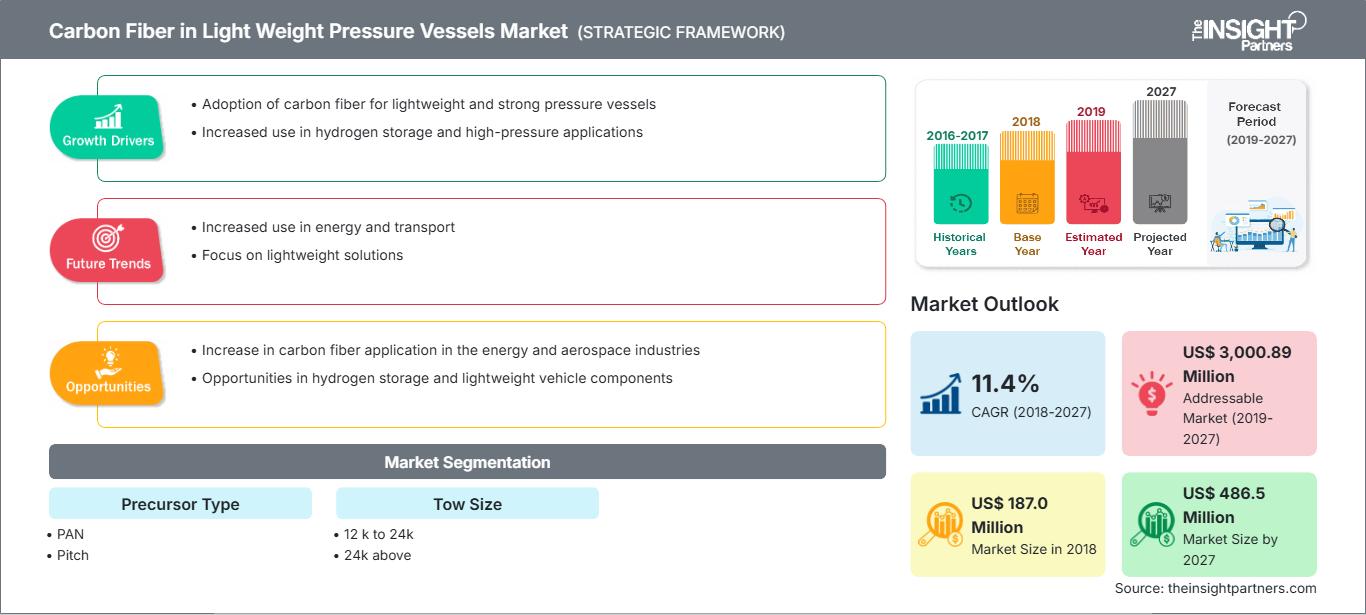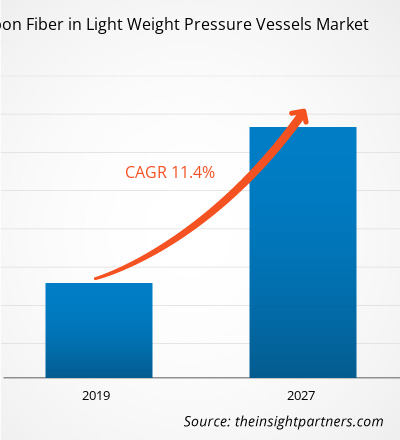El mercado global de fibra de carbono en recipientes a presión livianos representó US$ 187,0 millones en 2018 y se espera que crezca a una CAGR de 11,4% durante el período de pronóstico 2019 - 2027, para alcanzar los US$ 486,5 millones en 2027.
La región APAC es la de mayor crecimiento en recipientes a presión de fibra de carbono, debido al aumento de la población y a la creciente preocupación ambiental de gobiernos como India, China y Japón, junto con la creciente atención a los vehículos de GNC energéticamente eficientes y respetuosos con el medio ambiente . Además, se espera que la creciente demanda de la industria automotriz impulse el crecimiento del mercado de recipientes a presión ligeros de fibra de carbono en la región.
Perspectivas del mercado
Las crecientes demandas de las aplicaciones automotrices e industriales brindan una oportunidad para el crecimiento del mercado de fibra de carbono en recipientes a presión livianos.
La fibra de carbono ofrece un alto módulo y resistencia específica, alta resistencia a la fatiga, alta rigidez, alta capacidad de soportar presiones, menor coeficiente de expansión térmica, resistencia a la corrosión y otras propiedades beneficiosas, lo que la hace útil en recipientes a presión para aplicaciones automotrices y otras aplicaciones industriales. Además, se espera que la creciente demanda de materiales ligeros, junto con las iniciativas gubernamentales para reducir las emisiones de gases nocivos y aumentar la eficiencia del combustible, impulse el mercado de la fibra de carbono en recipientes a presión ligeros para aplicaciones automotrices.
Recibirá personalización de cualquier informe, sin cargo, incluidas partes de este informe o análisis a nivel de país, paquete de datos de Excel, y además aprovechará grandes ofertas y descuentos para empresas emergentes y universidades.
Mercado de fibra de carbono en recipientes a presión ligeros: Perspectivas estratégicas

- Obtenga las principales tendencias clave del mercado de este informe.Esta muestra GRATUITA incluirá análisis de datos, desde tendencias del mercado hasta estimaciones y pronósticos.
La creciente aplicación de recipientes a presión basados en fibra de carbono en vehículos de pila de combustible creará oportunidades de crecimiento para el mercado global de fibra de carbono en recipientes a presión ligeros.
Se prevé que el mercado global de fibra de carbono en recipientes a presión ligeros experimente una creciente demanda de fibra de carbono en recipientes herméticos para el almacenamiento de hidrógeno a alta presión. La fibra de carbono se considera la mejor opción para la producción de recipientes a presión fiables y seguros, ya que puede soportar la alta presión del hidrógeno. Por ello, los fabricantes de automóviles globales participan cada vez más en el desarrollo de vehículos de pila de combustible, y los respectivos gobiernos nacionales también apoyan la construcción de infraestructura para la producción de estos vehículos.
Perspectivas de los precursores
En función de los precursores, el mercado global de fibra de carbono para recipientes a presión ligeros se ha segmentado en poliacrilonitrilo (PAN) y brea. El segmento de poliacrilonitrilo (PAN) lideró el mercado global de fibra de carbono para recipientes a presión ligeros. El poliacrilonitrilo (PAN) es una fibra de carbono que contiene aproximadamente un 68 % de carbono y es uno de los precursores más utilizados para fibras de carbono. El PAN se polimeriza a partir del acrilonitrilo (AN) mediante inhibidores comunes, como compuestos azoicos y peróxidos, mediante el proceso de polimerización. La creciente demanda de fibra de carbono para recipientes a presión ligeros ha impulsado un aumento en la fabricación y producción de PAN, ya que es uno de los precursores más utilizados.
Información sobre el tamaño del remolque
El mercado global de fibra de carbono para recipientes a presión ligeros, según el tamaño de cable, se ha segmentado en fibras de carbono de 12k a 24k y superiores a 24k. Este segmento representó la mayor participación en el mercado global de fibra de carbono para recipientes a presión ligeros. La naturaleza pesada y rígida de las fibras de carbono de 12k a 24k resulta beneficiosa en aplicaciones de equipos militares y científicos, lo que contribuye significativamente a su crecimiento y expansión a nivel mundial. Entre los principales fabricantes de fibra de carbono de 12k a 24k se encuentran Toray Composite Materials America, Inc., Teijin Limited y SGL Group, entre muchos otros.
Perspectivas regionales del mercado de fibra de carbono en recipientes a presión ligeros
Los analistas de The Insight Partners han explicado detalladamente las tendencias y los factores regionales que influyen en el mercado de fibra de carbono en recipientes a presión ligeros durante el período de pronóstico. Esta sección también analiza los segmentos y la geografía del mercado de fibra de carbono en recipientes a presión ligeros en América del Norte, Europa, Asia Pacífico, Oriente Medio y África, y América del Sur y Central.
Alcance del informe de mercado sobre la fibra de carbono en recipientes a presión ligeros
| Atributo del informe | Detalles |
|---|---|
| Tamaño del mercado en 2018 | US$ 187,0 millones |
| Tamaño del mercado en 2027 | US$ 486,5 millones |
| CAGR global (2018-2027) | 11,4% |
| Datos históricos | 2016-2017 |
| Período de pronóstico | 2019-2027 |
| Segmentos cubiertos | Por tipo de precursor
|
| Regiones y países cubiertos | América del norte
|
| Líderes del mercado y perfiles de empresas clave |
|
Densidad de los actores del mercado de fibra de carbono en recipientes a presión ligeros: comprensión de su impacto en la dinámica empresarial
El mercado de la fibra de carbono en recipientes a presión ligeros está creciendo rápidamente, impulsado por la creciente demanda del usuario final debido a factores como la evolución de las preferencias de los consumidores, los avances tecnológicos y un mayor conocimiento de los beneficios del producto. A medida que aumenta la demanda, las empresas amplían su oferta, innovan para satisfacer las necesidades de los consumidores y aprovechan las tendencias emergentes, lo que impulsa aún más el crecimiento del mercado.

- Obtenga una descripción general de los principales actores del mercado de fibra de carbono en recipientes a presión ligeros.
Las fusiones y adquisiciones, el desarrollo de nuevos productos y otras estrategias se consideraron las más adoptadas en el mercado global de fibra de carbono para recipientes a presión ligeros. A continuación, se enumeran algunos de los desarrollos recientes en este mercado:
- 2019: Teijin Limited acordó adquirir Renegade Materials Corporation (Renegade) a través de la cual Teijin busca fortalecer sus negocios de fibra de carbono y materiales intermedios para mantener su posición como proveedor líder de soluciones para aplicaciones aeroespaciales.
- 2018: Toray Industries Inc. firmó un acuerdo con Koninklijke Ten Cate BV para comprar todas las acciones de su subsidiaria TenCate Advanced Composites Holding BV. Se esperaba que esta adquisición produjera sinergias sustanciales al combinar la línea de productos de esta última con la gama de tecnologías de fibra de carbono junto con polímeros.
- 2017: Hexcel lanzó MAXIM, un nuevo proyecto respaldado por el gobierno con £7,4 millones en investigación y desarrollo de telas de fibra de carbono y amplió su planta de fabricación en Leicester.
SEGMENTACIÓN DEL MERCADO GLOBAL DE FIBRA DE CARBONO EN RECIPIENTES A PRESIÓN LIGEROS
Por precursores
- Poliacrilonitrilo (PAN)
- Paso
Por tamaño de remolque
- 12k a 24k
- Más de 24k
Por geografía
- América del norte
- A NOSOTROS
- Canadá
- México
- Europa
- Alemania
- Francia
- Italia
- Reino Unido
- Rusia
- Resto de Europa
- Asia Pacífico
- Australia
- Porcelana
- India
- Japón
- Corea del Sur
- Resto de Asia Pacífico
- Resto del mundo
- Brasil
- Argentina
- Resto de Sudamérica (SAM)
Perfiles de empresas
- CORPORACIÓN HYOSUNG
- Solvay
- Corporación de Plásticos Formosa
- Industrias Toray, Inc.
- Teijin Limitada
- Carbono SGL
- Corporación química Mitsubishi
- Corporación Kureha
- Corporación Hexcel
- Dowaksa
- Análisis histórico (2 años), año base, pronóstico (7 años) con CAGR
- Análisis PEST y FODA
- Tamaño del mercado, valor/volumen: global, regional y nacional
- Industria y panorama competitivo
- Conjunto de datos de Excel
Informes recientes
Informes relacionados
Testimonios
Razón para comprar
- Toma de decisiones informada
- Comprensión de la dinámica del mercado
- Análisis competitivo
- Información sobre clientes
- Pronósticos del mercado
- Mitigación de riesgos
- Planificación estratégica
- Justificación de la inversión
- Identificación de mercados emergentes
- Mejora de las estrategias de marketing
- Impulso de la eficiencia operativa
- Alineación con las tendencias regulatorias




















 Obtenga una muestra gratuita para - Fibra de carbono en el mercado de recipientes a presión ligeros
Obtenga una muestra gratuita para - Fibra de carbono en el mercado de recipientes a presión ligeros